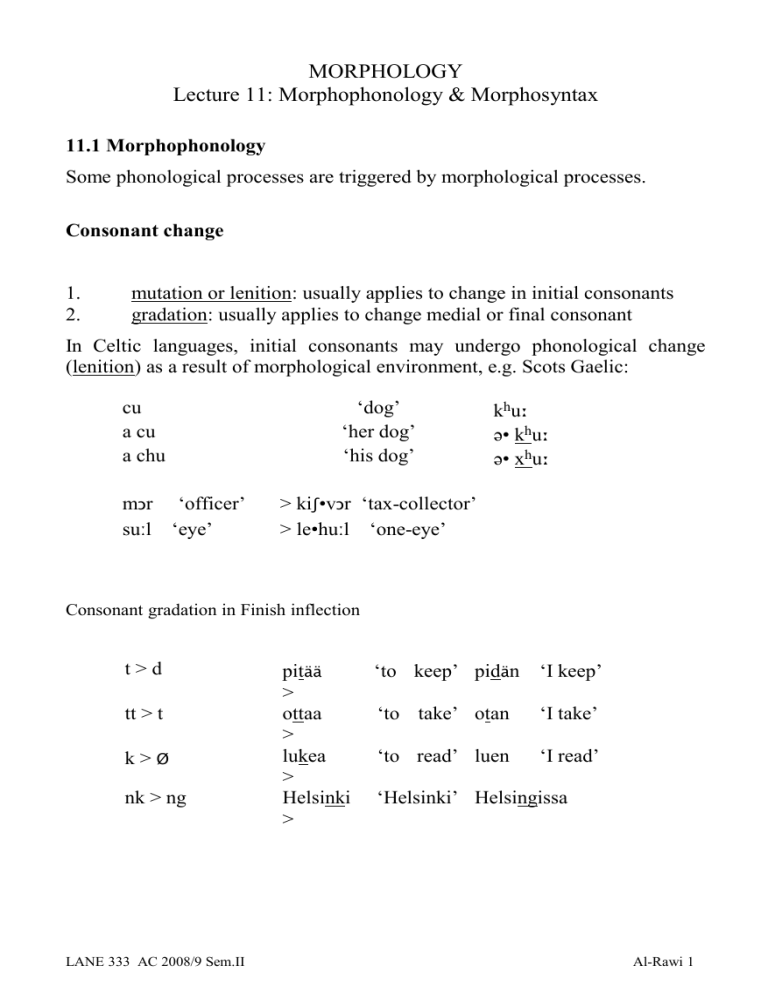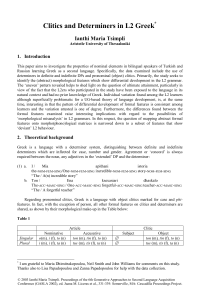MORPHOLOGY Lecture 11: Morphophonology & Morphosyntax 11
advertisement

MORPHOLOGY Lecture 11: Morphophonology & Morphosyntax 11.1 Morphophonology Some phonological processes are triggered by morphological processes. Consonant change 1. 2. mutation or lenition: usually applies to change in initial consonants gradation: usually applies to change medial or final consonant In Celtic languages, initial consonants may undergo phonological change (lenition) as a result of morphological environment, e.g. Scots Gaelic: cu a cu a chu mɔr ‘officer’ suːl ‘eye’ ‘dog’ ‘her dog’ ‘his dog’ khuː ə• khuː ə• xhuː > kiʃ•vɔr ‘tax-collector’ > le•huːl ‘one-eye’ Consonant gradation in Finish inflection t>d tt > t k>Ø nk > ng LANE 333 AC 2008/9 Sem.II pitää > ottaa > lukea > Helsinki > ‘to keep’ pidän ‘I keep’ ‘to take’ otan ‘I take’ ‘to read’ luen ‘I read’ ‘Helsinki’ Helsingissa Al-Rawi 1 Stress change English N > V derivation 'increase 'transport 'import 'contrast 'torment increase trans'port im'port con'trast tor'ment Vowel harmony Mongolian comitative ("with") case inflection xɪɾɪk ‘daugher’ > xɪɾɪktei ‘with daughter’ tsõx ‘window’ > tsõxtõi ‘with window’ mɔxɬak ‘kiosk’ > mɔxɬaktai ‘with kiosk’ 11.2 Morphosyntax Morphological process may be linked with phrasal/clausal syntax. Passive Causative Case and agreement Case and agreement reflect dependency relations via morphology A. Subject-verb: English, I love ~ she loves B. Subject-verb-object: Northern Sotho (Bantu, South Africa; from Tallerman p. 160): Ngwana mpša e-mo-lomile (mo marks ‘child’ noun class) child dog SUBJ-OBJ-bit ‘As for the child, the dog bit him/her’ LANE 333 AC 2008/9 Sem.II Al-Rawi 2 C. Subject-verb-object-indirect object: Kambera (Malayo-Polynesian; Sumba l.; from Tallerman p. 161) I ama na-kei-ngga-nya the father 3SG:NOM-buy-1SG:DATIVE-3SG:DATIVE ‘Father buys it for me’ Tense/aspect Debbie shouted at her mother and started crying. *Debbie shouted at her mother and starts crying. *Debbie shouted at her mother and will starts crying. Clitics Clitics: element which shares properties with both words and affixes. French Donnez-moi les livres give me the books ‘Give me the books’ Donnez-les moi. give them me ‘Give them to me’ Il a donné les livres à moi he has given the books to me ‘He gave the books to me’ Il me les a donné He me them has given ‘He gave me them’ English The vice-president’s been hoeing the garden all day. Three of his close friends’ve said they hate his new haircut. The red-nosed clown’s purple wig fell off suddenly. LANE 333 AC 2008/9 Sem.II Al-Rawi 3 Clitics…. attach to inflected hosts attach to phrases, not heads may be restricted to certain positions in sentences may have to occur in certain order Compounding Resemble a syntactic process See lecture 5 for some distinguishing tests Noun Incorporation Morphological process whereby an object noun attaches itself to a verb to form a new lexeme. Chukchee Tə-pelarkən qoraŋə I -leave reindeer ‘I'm leaving the reindeer’ tə-qora-pelarkən I-reindeer-leave ‘I’m reindeer-leaving’ English (gerunds only) They went strawberry-picking last weekend. I see you've been doing too much TV-watching. The politician made her name saber-rattling. Noun incorporation only works with objects or instruments of verb, not subjects. Conclusion: Morphological rules do not operate in a vaccum Morphology interacts closely with both syntactic rules and phonological rules. LANE 333 AC 2008/9 Sem.II Al-Rawi 4








